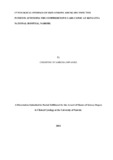| dc.description.abstract | According to WHO report of 2011, there were 34.0 million people living
with Human immunodeficiency virus (HIV) in the world. Sub-Saharan Africa remains
most severely affected, with South Africa carrying the largest burden. In 2012, Kenya
showed that approximately 5.6% of the adult population was HIV infected.
Cytopathology of skin lesions in HIV infection has been poorly studied in sub-Saharan
Africa. HIV infected individuals are living longer due to HAART. The spectrum of
cutaneous malignancies has expanded to include both AIDS defining cancers as well as
non AIDS defining cancers (NADC).These skin conditions impair patients’ quality of
life. Using exfoliative cytology, this study highlighted on specific infections,
inflammations, ulcerations and neoplasms likely to be encountered in this setting and
has also given the current shift in the pattern of HIV related diseases thus improving on
patient care.
Objective: To describe the cytological findings of skin lesions in HIV infected patients that
attended CCC at Kenyatta National Hospitals, Nairobi.
Design: A cross- sectional descriptive study.
Setting: Recruitment and sample collection was done at CCC at KNH. Sample processing
was done at UON cytology laboratory.
Study Population: HIV infected patients in the CCC at KNH who had skin complaints and
met the inclusion criteria.
Method: One hundred (100) patients were recruited and group counselled on the
importance of the study. A structured questionnaire was used to collect socio-demographic
information and clinical history. Cytology sampling techniques: touch preparations, FNA
and scrapings were used to collect the material from the lesions. Three smears of the
collected material were made. Two were stained with Papanicolaou and heamatoxylin
respectively, and the other air dried for special stain. In this study Periodic acid Schiff and
Ziehl Neelsen stains were used as warranted. The principal investigator examined the
preparations then reviewed them with the pathologists. A tie breaker was sought for
controversial cases.
Results: All participants were black. The female to male ratio in this study was 3:1 (73% &
27% respectively. The peak age group was 41 to 50 years (36%) with mean age of 41.47yrs,
(SD of 11.46). Majority hailed from Nairobi County. Cytological findings; 41% were
negative for cytological lesions, 32% were inflammatory (Nonspecific inflammation 21%,
viral 6% and 5% fungal), 5% were malignant (KS 2% and SCC 3%) and for the purpose of
analysis 22% were grouped as others. There was a significant difference on skin cytology
and clinical findings at 95% confidence interval because the p value was less than 0.001 and
the chi square statistics was 1089. There was no evidence of significant difference in
cytological findings of patients on and not on HAART.
Conclusion: The commonest cytological changes were inflammatory. Malignant skin
lesions are rare presentations in HIV infection among the studied population.
Recommendations: Cytology is a valuable, affordable and a quick diagnostic tool that should
be incorporated in the routine management of HIV-related skin lesions. | en_US |

